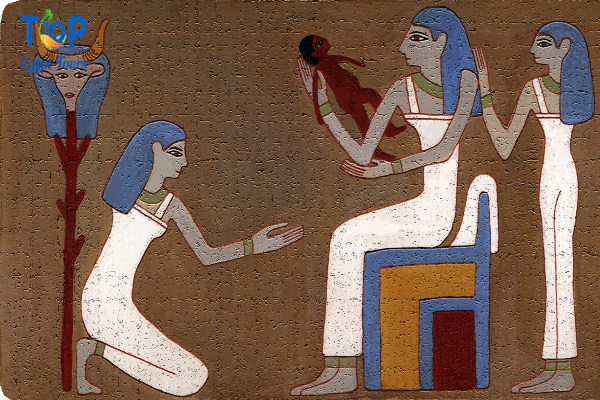Meskhenet: Guardian of Birth and Life, Welcome to the enchanting world of Ancient Egyptian mythology, where gods and goddesses governed every aspect of life. Among the pantheon of deities, Meskhenet shines brightly as the goddess of childbirth and the protector of new life. In this fascinating journey through time, we’ll explore the captivating tales surrounding Meskhenet and her enduring significance in Egyptian culture.
Meskhenet: Guardian of Birth and Life’s Role in Ancient Egyptian Society
Meskhenet’s Origins and Symbolism:
Meskhenet, also known as the Lady of Birth, held a pivotal role in Ancient Egyptian society. She was believed to be the personification of the birthing bed or birthing brick, representing the essential place where new life was brought into the world. Depicted as a humanoid goddess, usually donning a headdress resembling a woman’s uterus, she emanated a divine aura of protection and nurturing.
Meskhenet’s Divine Duties During Childbirth
Meskhenet: Guardian of Birth and Life, Guardian of Expectant Mothers:
Meskhenet played a vital role during childbirth, offering her divine guidance and protection to expectant mothers. Egyptian women turned to her for support and encouragement during the laborious journey of bringing new life into the world. Meskhenet was believed to watch over the mothers and guide them safely through the birthing process, ensuring a healthy delivery for both mother and child.
Meskhenet and the Cycle of Life and Death
From Birth to Afterlife:
Meskhenet’s influence extended beyond childbirth and into the realms of life and death. It was believed that she also held pivotal roles in the judgment of souls and the determination of one’s fate in the afterlife. In this way, Meskhenet became a transformative figure, overseeing the entire cycle of life and ensuring the protection and guidance of both the living and the deceased.
Meskhenet’s Connection with Other Egyptian Deities
Companions in Birth and Beyond:
Meskhenet was often accompanied by other deities associated with fertility and childbirth, such as Taweret, the goddess of pregnancy, and Bes, the protector of households. Together, these divine figures formed a powerful triumvirate, offering a web of protection and blessings to all aspects of family life. Their unity encapsulated the Ancient Egyptians’ belief in the interconnectedness of divine forces.
Meskhenet in Egyptian Art and Architecture
Meskhenet’s Iconography:
The artistic representations of Meskhenet in Ancient Egyptian art and architecture provide a glimpse into the veneration and reverence bestowed upon this goddess. From temple reliefs to amulets and statuettes, her image adorned sacred spaces and talismans, serving as a constant reminder of her influence and divine protection. The intricate details in her depictions highlight the meticulous craftsmanship and devotion of the Ancient Egyptians.
Meskhenet Today: Preserving the Legacy
Continuing Influence:
Though the worship of ancient deities has waned over the centuries, the legacy of Meskhenet and her significance in childbirth remain alive in modern Egypt. The spiritual strength and reverence she represented are still honored, as mothers seek a safe and successful delivery, often invoking the essence of Meskhenet in their prayers and rituals.
Exploring Egypt’s Rich Mythological Heritage
As we delve deeper into the mesmerizing world of Ancient Egyptian mythology, the goddess Meskhenet emerges as a beacon of hope, protection, and guidance. Her role as the guardian of childbirth and life highlights the profound importance placed on the beginning of life’s journey. Exploring Egypt’s rich mythological heritage adds a layer of enchantment to any visit to this remarkable country, offering a deeper appreciation of its cultural tapestry.
In the land of pharaohs and pyramids, Meskhenet’s enduring presence serves as a testament to the timeless power of mythology in shaping our understanding of life, death, and the unbreakable bond between the divine and mortal realms.



Comment (0)